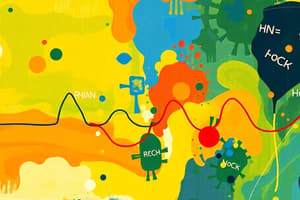Podcast
Questions and Answers
What happens to the backward reaction in an irreversible reaction?
What happens to the backward reaction in an irreversible reaction?
- It is considered in the rate expression.
- It influences the equilibrium constant.
- It proceeds at the same rate as the forward reaction.
- It is ignored entirely. (correct)
What does the term 'K' represent in the equilibrium expressions?
What does the term 'K' represent in the equilibrium expressions?
- The equilibrium constant. (correct)
- The concentration of reactants.
- The rate constant for the forward reaction.
- The change in enthalpy.
In the law of mass action, a correct rate expression is obtained when applied to:
In the law of mass action, a correct rate expression is obtained when applied to:
- Elementary reaction steps that are rate controlling. (correct)
- Overall reactions only.
- Irreversible reactions exclusively.
- All types of chemical reactions.
According to the Arrhenius Equation, how does temperature affect the rate constant?
According to the Arrhenius Equation, how does temperature affect the rate constant?
What does the Van’t Hoff equation relate to in terms of chemical reactions?
What does the Van’t Hoff equation relate to in terms of chemical reactions?
In the context of rate constants, what does the symbol 'A' represent?
In the context of rate constants, what does the symbol 'A' represent?
What information does the change in enthalpy ($
abla H$) provide in chemical reactions?
What information does the change in enthalpy ($ abla H$) provide in chemical reactions?
What is the relationship between the forward rate constant ($K_f$) and the backward rate constant ($K_b$)?
What is the relationship between the forward rate constant ($K_f$) and the backward rate constant ($K_b$)?
What characterizes a homogeneous reaction?
What characterizes a homogeneous reaction?
In a heterogeneous reaction, where does the reaction primarily occur?
In a heterogeneous reaction, where does the reaction primarily occur?
Which of the following statements is true regarding the rate of heterogeneous reactions?
Which of the following statements is true regarding the rate of heterogeneous reactions?
Which process is NOT involved in a heterogeneous reaction?
Which process is NOT involved in a heterogeneous reaction?
What is the primary factor that affects the rate of a heterogeneous reaction involving solids?
What is the primary factor that affects the rate of a heterogeneous reaction involving solids?
What is the nature of the rate of reaction in a homogeneous reaction?
What is the nature of the rate of reaction in a homogeneous reaction?
Which statement describes the reaction mechanisms in homogeneous vs. heterogeneous reactions?
Which statement describes the reaction mechanisms in homogeneous vs. heterogeneous reactions?
What may represent a heterogeneous reaction?
What may represent a heterogeneous reaction?
Which reaction is likely to proceed faster due to the involvement of a gas?
Which reaction is likely to proceed faster due to the involvement of a gas?
What is the role of a catalyst in a chemical reaction?
What is the role of a catalyst in a chemical reaction?
How does the concentration of hydrochloric acid change with time in the reaction CaCO3 + 2HCl?
How does the concentration of hydrochloric acid change with time in the reaction CaCO3 + 2HCl?
Which of the following can be considered a negative catalyst?
Which of the following can be considered a negative catalyst?
What defines the order of a reaction?
What defines the order of a reaction?
Which of the following statements is true regarding Reaction (3)?
Which of the following statements is true regarding Reaction (3)?
In the context of chemical reactions, what effect does increasing temperature have on Reaction (1)?
In the context of chemical reactions, what effect does increasing temperature have on Reaction (1)?
Which catalyst is commonly used in the reforming of natural gas?
Which catalyst is commonly used in the reforming of natural gas?
What does the integration constant (C) equal when $t = 0$ and $x = 0$?
What does the integration constant (C) equal when $t = 0$ and $x = 0$?
At what point is $x$ equal to $
rac{a}{2}$?
At what point is $x$ equal to $ rac{a}{2}$?
In the differential method for a first-order reaction, what is the relationship between the rate of change of concentration and the concentration itself?
In the differential method for a first-order reaction, what is the relationship between the rate of change of concentration and the concentration itself?
How can the order of a reaction (n) be determined?
How can the order of a reaction (n) be determined?
What is the expression for the rate of reaction in a general nth order reaction involving one substance?
What is the expression for the rate of reaction in a general nth order reaction involving one substance?
Which equation describes the relationship between the two different initial concentrations for the same nth order reaction?
Which equation describes the relationship between the two different initial concentrations for the same nth order reaction?
What does the value of K represent in the context of reaction order?
What does the value of K represent in the context of reaction order?
In the context of nth order reactions, what condition must be satisfied to simplify the expression for K?
In the context of nth order reactions, what condition must be satisfied to simplify the expression for K?
Which formula(s) relate to the derivation of the rate of reaction for nth order?
Which formula(s) relate to the derivation of the rate of reaction for nth order?
What is the significance of $ log K[A_1] - log K[A_2] $ in determining reaction order?
What is the significance of $ log K[A_1] - log K[A_2] $ in determining reaction order?
What does the activation energy (E) represent in a chemical reaction?
What does the activation energy (E) represent in a chemical reaction?
In the Arrhenius equation K = A exp(−E/RT), what does the variable K represent?
In the Arrhenius equation K = A exp(−E/RT), what does the variable K represent?
What does ln K = ln A − (E/RT) illustrate when plotted as ln K vs (1/T)?
What does ln K = ln A − (E/RT) illustrate when plotted as ln K vs (1/T)?
Which of the following factors does NOT affect the rate of heterogeneous reactions?
Which of the following factors does NOT affect the rate of heterogeneous reactions?
In the context of kinetic studies, what is the rate controlling step?
In the context of kinetic studies, what is the rate controlling step?
If the activation energy of a reaction increases, what is the likely effect on the reaction rate with temperature?
If the activation energy of a reaction increases, what is the likely effect on the reaction rate with temperature?
What does the frequency factor (A) in the Arrhenius equation represent?
What does the frequency factor (A) in the Arrhenius equation represent?
Which statement accurately describes the Arrhenius equation?
Which statement accurately describes the Arrhenius equation?
Flashcards are hidden until you start studying
Study Notes
Rate Expressions
- Reversible Reactions: The rate expression for a reversible reaction is given by:
- Kf / Kb = (CxCY) / (CMCN) = K
- Where K is the equilibrium constant, Kf is the forward rate constant, Kb is the backward rate constant, Cx is the concentration of X, CY is the concentration of Y, CM is the concentration of M, and CN is the concentration of N.
- Kf / Kb = (CxCY) / (CMCN) = K
- Irreversible Reactions: For irreversible reactions, the backward reaction is ignored. The rate expression simplifies to:
- (n0/V) = KfCMCN
- Where n0 is the initial number of moles, V is the volume, and Kf is the forward rate constant.
- (n0/V) = KfCMCN
Rate Controlling Step
- The rate constant is determined by the slowest step in a multi-step reaction.
- Elementary Reactions: The law of mass action can be applied to elementary steps, which represent the individual steps in a reaction mechanism.
- Rate Controlling Step: The slowest step in the mechanism dictates the overall rate of the reaction.
Arrhenius Equation
- Describes the relationship between temperature and the rate constant of a reaction.
- Arrhenius Equation: K = Ae^(-E/RT)
- Where K is the rate constant, A is the frequency factor, E is the activation energy, R is the ideal gas constant, and T is the absolute temperature.
- Activation Energy (E): The minimum amount of energy that reactant molecules must possess to overcome the energy barrier and form products
- Frequency Factor (A): Represents the frequency of collisions between reactant molecules.
Reaction Order
- Represents the power to which the concentration of each reactant is raised in the rate law.
- Overall Order: Sum of the individual orders of each reactant.
- First Order Reaction: Rate is directly proportional to the concentration of one reactant.
- Second Order Reaction: Rate is proportional to the square of the concentration of one reactant or the product of the concentrations of two reactants.
Types of Reactions
- Homogeneous Reactions: Occur entirely within a single phase, where reactants and products are in the same phase.
- Heterogeneous Reactions: Involve reactants and products in different phases and occur at the interface between phases.
Rate of Reaction
- Represents the change in concentration of a reactant or product over time.
- Rate Law: Mathematical expression that relates the rate of reaction to the concentrations of reactants.
Factors Affecting Reaction Rate
- Surface Area: Increased surface area in heterogeneous reactions leads to a faster rate of reaction due to more opportunities for collisions at the interface.
- Catalyst: Alters the rate of a reaction without being consumed itself.
- Positive Catalyst: Increases the rate of reaction.
- Negative Catalyst (Inhibitor): Decreases the rate of reaction.
- Concentration: Increasing the concentration of reactants generally leads to a faster reaction rate due to more frequent collisions.
- Temperature: Increased temperature typically leads to a faster reaction rate due to increased kinetic energy of molecules, leading to more successful collisions.
Heterogeneous Reactions
- Involve reactants and products in different phases.
- Key Steps:
- Transport of Reactants: Movement of reactants to the reaction site.
- Chemical Reaction: Conversion of reactants to products at the reaction site.
- Transport of Products: Movement of products away from the reaction site.
- Rate Controlling Step: The slowest step in the process that determines the overall rate of reaction.
Studying That Suits You
Use AI to generate personalized quizzes and flashcards to suit your learning preferences.




